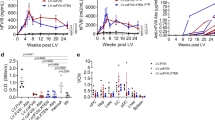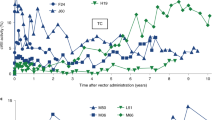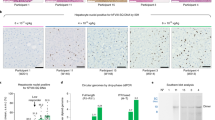Abstract
Haemophilia B, or factor IX deficiency, is an X-linked recessive disorder that occurs in about one in 25,000 males, and severely affected people are at risk for spontaneous bleeding into numerous organs. Bleeding can be life-threatening or lead to chronic disabilities with haemophilic arthropathy. The severity of the bleeding tendency varies among patients and is related to the concentration of functional plasma factor IX. Patients with 5–30% of the normal factor IX have mild haemophilia that may not be recognized until adulthood or after heavy trauma or surgery1. Therapy for acute bleeding consists of the transfusion of clotting-factor concentrates prepared from human blood and recombinant clotting factors that are currently in clinical trials. Both recombinant retroviral2 and adenoviral3 vectors have successfully transferred factor IX cDNA into the livers of dogs with haemophilia B. Recombinant retroviral-mediated gene transfer results in persistent yet subtherapeutic concentrations of factor IX and requires the stimulation of hepatocyte replication before vector administration. Recombinant adenoviral vectors can temporarily cure the coagulation defect in the canine haemophilia B model; however, an immune response directed against viral gene products made by the vector results in toxicity and limited gene expression3,4. The use of recombinant adeno-associated virus (rAAV) vectors is promising because the vector contains no viral genes and can transduce non-dividing cells5. The efficacy of in vivo transduction of non-dividing cells has been demonstrated in a wide variety of tissues6‐12. In this report, we describe the successful transduction of the liver in vivo using r-AAV vectors delivered as a single administration to mice and demonstrate that persistent, curative concentrations of functional human factor IX can be achieved using wild-type-free and adenovirus-free rAAV vectors. This demonstrates the potential of treating haemophilia B by gene therapy at the natural site of factor IX production.
This is a preview of subscription content, access via your institution
Access options
Subscribe to this journal
Receive 12 print issues and online access
$209.00 per year
only $17.42 per issue
Buy this article
- Purchase on Springer Link
- Instant access to full article PDF
Prices may be subject to local taxes which are calculated during checkout
Similar content being viewed by others
References
Reiner, A.P. & Davie, E.W. Introduction to hemostasis and the vitamin K-dependent coagulation factors. in The Metabolic Basis oJ Inherited Disease Vol. 3 (eds Scriver, C.R., Beaudet, A.L, Sly, W.S. & Valle, D.) 3181–3221 (McGraw-Hill, New York, 1995).
Kay, M.A. et al. In vivo gene therapy of hemophilia B: sustained partial correction in factor IX-deficient dogs. Science 262, 117–119 (1993).
Kay, M.A. et al. In vivo hepatic gene therapy: complete albeit transient correction of factor IX deficiency in hemophilia B dogs. Proc. Natl. Acad. Sci. USA 91, 2353–2357 (1994).
Yang, Y. et al. Cellular immunity to viral antigelns limits E1-deleted adenoviruses for gene therapy. Proc. Natl. Acad. Sci. USA 91, 4407–4411 (1994).
Muzyczka, N. Use of adeno-associated virus as a general transduction vector for mammalian cells. Curr. Top. Microbiol. Immunol. 158, 97–129 (1992).
Xiao, X., Li, J. & Samulski, R.J. Efficient long-term gene transfer into muscle of immunocompetent mice by an adeno-associatfed virus vector. J. Virol. 70, 8098–8108 (1996).
McCown, T.J., Xiao, X., Li, J., Breese, G.R. & Samulski, R.J. Differential and persistent expression patterns of CNS gene transfer by an adeno-associated virus (AAV) vector. Brain Res. 713, 99–107 (1996).
Kaplitt, M.G. et al. Long-term gene transfer into porcine myocadium following selective percutaneous coronary artery infusion of an adeno-associated virus vector. Ann. Thorac. Surg. 62, 1669–1676 (1996).
Kaplitt, M.G. et al. Long-term gene expression and phenotypic correction using adeno-associated virus vectors in the mammalian brain. Nature Genet. 8, 148–154 (1994).
Lalwani, A.K., Walsh, B.J., Reilly, P.G., Muzyczka, N. & Mhatre, A.N. Development of in vivo gene therapy for hearing disorders: Introduction of adeno-associated virus into the cochlea of guinea pig. Gene Ther. 3, 588–592 (1996).
Flotte, T.R. et al. Stable in vivo expression Of the cystic fibrosis transmembrane conductance regulator with an adeno-associaked virus vector. Proc Natl. Acad. Sci. USA. 90, 10613–10617 (1993).
Afione, S.A. et al. In vivo model of adeno-associated virus vector persistence and rescue. J. Virol. 70, 3235–3241 (1996).
Carter, B.J. The growth cycle of adeno-associattd virus. in Handbook of Parvoviruses. Vol. 1 (ed. Tijssen, P.) 155–168 (CRC Press, Boca Raton, FL, 1990).
Barr, D. et al. Strain related variations in adenovirally mediated transgene expression from mouse hepatocytes in vivo: comparisons between immunocompetent and immunodeficient inbred strains. Gene Ther. 2, 151–155 (1995).
Fisher, K.J.. et al. Transduction with recombinant adeno-associated virus for gene therapy is limited by leading-strand synthesis. J. Virol. 70, 520–532 (1996).
Dranoff, G. et al. Vaccination with irridateq tumor cells engineered to secrete murine granulocyte-macrophage colony-stimulating factor stimulate potent, specific, and long-lasting anti-tumor immunity. Proc. Natl. Acad. Sci. USA 90, 3539–3543 (1993).
Kay, M.A. et al. Hepatic gene therapy: persistertt expression of human arantitrypsin in mice after direct gene deliveryin vivo. Hum. Gene Ther. 3, 641–647 (1992).
Kay, M.A. et al. Expression of human α1-antitrypsin in dogs after autologous transplantation of retroviral transduced hepapcytes. Proc Natl. Acad. Sci. USA. 89, 89–93 (1992).
Guo, Z.S., Wang, L.H., Eisensmith, R.C. & Woo, S.L.C. Evaluation of promoter strength for hepatic gene expression in vivo following adenovirus-mediated gene transfer. Gene Ther. 3, 802–810 (1996).
Baskar, J.F. et al. The enhancer domain of the human cytomegalovirus major immediate-early promoter determines cell type-specific -specific expression in transgenic mice. J. Virol. 70, 3207–3214 (1996).
Bray, G.L., Weinmann, A.F. & Thompson, A.R. Calcium-specific immunoassays for fator IX: reduced levels of antigen in patients with vitamin K disorders. J. Lab. Clin. Med. 107, 269–278 (1986).
Ferrari, F.K., Samulski, T., Shenk, T. & Samulski, R.J. Second-strand synthesis is a rate limiting step for efficient transduction by recombinant adeno-associated virus vectors. J. Virol. 70, 3227–3234 (1996).
Alexander, I.E., Russell, D.W. & Miller, A.D. DNA-damaging agents greatly increase the transduction of nondividing cells by adeno-associated virus vectors. J. Virol. 68, 8282–8287 (1994).
McLaughlin, S.K., Collis, P., Hermonat, P.L. & Muzyczka, N. Adeno-associated virus general transduction vectors: analysis of proviral structures. J. Virol. 62, 1963–1973 (1988).
Kessler, P.D. et al. Gene delivery to skeletal muscle results in sustained expression and systemic delivery of a therapeutic protein. Proc. Natl. Acad. Sci. USA 93, 14082–14087 (1996).
Vrancken Peeters, M.T.F.D., Lieber, A., Perkins, J. & Kay, M.A. Method for multiple portal vein infusions in mice: Quantitation of adenovirus-mediated hepatic gene transfer. Biotechniques 20, 278–285 (1996).
Lieber, A., He, C.-Y., Kirllova, I. & Kay, M.A. Recombinant adenoviruses with large deletions generated by Cre-mediated excision exhibit different biological properties compared with first-generation vectors in vitro and in vivo. J. Virol. 70, 8944–8960 (1996).
Kay, M.A. & Woo, S.L.C. Gene therapy for metabolic disorders. Trends Genet. 10, 253–257 (1994).
Su, H., Chang, J.C., Xu, S.M. & Kan, Y.W. Selective killing of AFP-positive hepatocellular carcinoma cells by adeno-associated virus transfer of the herpes simplex virus thymidine kinase gene. Hum. Gene Ther. 7, 463–470 (1996).
St. Louis, D. & Verma, I.M. An alternative approach to somatic cell gene therapy. Proc. Natl. Acad. Sci. USA 85, 3150–3154 (1988).
Snyder, R.O., Xiao, X. Production of recombinant adeno-associated viral vectors. in Current Protocols in Human Genetics Vol. 1 (eds Dracopoli, N. et al.) 1–24 (John Wiley & Sons, New York, 1996).
Graham, F.L., Smiley, J., Russell, W.C. & Nairn, R. Characterization of a human cell line transformed by DNA from human adenovirus type 5. J. Gen. Virol. 36, 59–74 (1977).
Li, J., Samulski, R.J. & Xiao, X. Role for highly regulated rep gene expression in adeno-associated virus vector production. J. Virol. (in the press).
Thompson, A.R. & Counts, R.B. Removal of heparin and protamine from plasma. J. Lab. Clin. Med. 88, 922–929 (1976).
Thompson, A.R. Monoclonal antibody to an epitope on the heavy chain of factor IX missing in three hemophilia B patients. Blood 62, 1027–1034 (1983).
Schowalter, D.B., Tubb, J.C., Liu, M., Wilson, C.B. & Kay, M.A. Heterologous expression of adenovirus E3-gp19K in an E1a deleted adenovirus vector inhibits MHCI expression in vitro but does not prolong transgene expression in vivo. Gene Ther. 4, 351–360 (1997).
Author information
Authors and Affiliations
Corresponding author
Rights and permissions
About this article
Cite this article
Snyder, R., Miao, C., Patijn, G. et al. Persistent and therapeutic concentrations of human factor IX in mice after hepatic gene transfer of recombinant AAV vectors. Nat Genet 16, 270–276 (1997). https://doi.org/10.1038/ng0797-270
Issue Date:
DOI: https://doi.org/10.1038/ng0797-270
This article is cited by
-
Gene Therapy for Hemophilia: Progress to Date
BioDrugs (2018)
-
Ultrasound-targeted hepatic delivery of factor IX in hemophiliac mice
Gene Therapy (2016)
-
Strategies to generate high-titer, high-potency recombinant AAV3 serotype vectors
Molecular Therapy - Methods & Clinical Development (2016)
-
Efficient and Targeted Transduction of Nonhuman Primate Liver With Systemically Delivered Optimized AAV3B Vectors
Molecular Therapy (2015)
-
Comparative Study of Liver Gene Transfer With AAV Vectors Based on Natural and Engineered AAV Capsids
Molecular Therapy (2015)



